
Original Link: https://www.anandtech.com/show/2508
Western Digital VelociRaptor: A Drive with a Bite
by Gary Key on April 22, 2008 4:00 AM EST- Posted in
- Storage
The original Western Digital Raptor was launched as the WD360GD in March of 2003 with an enterprise level 10,000 RPM spindle speed, SATA interface, 8MB buffer, 5.2 millisecond read seek time, and a single-platter design featuring 36GB of storage. While it shined in single-user performance, the drive did not fare well against its SCSI-based competitors in the enterprise server market. Limited by size and a complete lack of command queuing abilities, it delivered performance that was not up to par with the SCSI drives in critical multi-user scenarios. However, due to the lack of entry-level SCSI drives, a growing interest in SATA components, and a very avid computer enthusiast market, the drive was able to succeed and build a sterling reputation for Western Digital in the SATA market.
The next version of the Raptor launched as the WD740GD in December of 2003 and boasted several needed enhancements. These enhancements included a capacity upgrade to 74GB, 4.6 millisecond read seek time, a FDB based motor to address noise concerns, and ATA-4 tagged command queuing. While TCQ was a welcome addition and certainly improved the drive's I/O operations, it still was not a match for most SCSI drives in the enterprise market. This was primarily due to a lack of SATA controllers that fully supported TCQ and firmware that was not as mature as the SCSI competition.
Computer enthusiasts flocked to the drive due to its performance advantages, but the drive continued to have limited success in the enterprise server market. The last major update to the Raptor family occurred in January of 2006 when the WD1500ADFD launched with a significant list of improvements. This drive still sported the familiar 10,000 RPM spindle speed, 4.6ms read seek time, and a two-platter design now at 150GB capacity. The platter's density increased to 75GB+ and equaled that of several 10,000 RPM SCSI competitors. The buffer size doubled to 16MB, matching the latest offerings from other drive manufacturers, and a native SATA implementation with Native Command Queuing became standard.
The WD1500ADFD became the de facto drive for enthusiasts and for a while, its 150GB capacity was acceptable. (Price was still a concern for some, of course, and many people were content to get larger, cheaper, quieter drives that performed more than adequately in most usage scenarios.) Since the drive's introduction, we have seen an explosion in capacities with terabyte drives becoming normal fare from the drive suppliers and the sweet spot in the drive market slowly inching up to the 500GB range now. Not only did the capacity of the Raptor series seem small, the latest SATA 3 Gb/s 7200RPM drives were starting to offer equal or better performance in several areas at greatly reduced per-gigabyte prices.
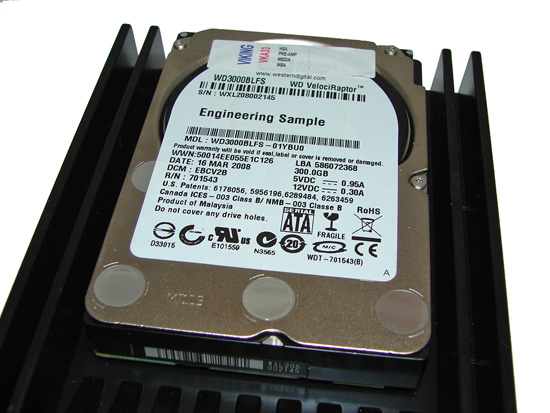
As of today, Western Digital is announcing their fourth-generation design, aptly named the "VelociRaptor" as a nod to its promised capabilities. The capacity is now at 300GB and that is the least of changes for the new VR150 product family. Western Digital took a serious look at the enterprise market and determined they needed a product design that could compete in the widely expanding enterprise market where 2.5" form factor drives are taking a foothold due to the ability to pack more drives into the same chassis footprint. The other advantage to a 2.5" form factor is reduced power consumption, a hot topic in today's energy-aware world.
With that market in mind, Western Digital has moved to a 2.5" form factor with the VelociRaptor, while at the same time providing a unique 3.5" chassis mounting system for the enthusiast desktop market. This mounting system is named "IcePAK" and features a finned aluminum design that offers some degree of thermal dissipation. However, its primary purpose is to ensure this drive works in the multitude of desktop chassis. The drawback is the IcePAK mounting system does not work with standard SATA backplanes found in several rack-mounted servers. To address the enterprise market, WD will ship the drive without the IcePAK chassis.
Let's take a quick look at our preview results today. 5/2/08 - We have updated the test scores with results from a new drive supplied by Western Digital.
When Smaller is Better
| Specification | |||
| WD
VelociRaptor WD3000BLFS |
Western Digital
Raptor WD1500ADFD |
Western Digital
Raptor WD740ADFD |
|
| Capacity | 300GB | 150GB | 74GB |
| Interface | SATA 3 Gb/s | SATA 1.5 Gb/s | SATA 1.5 Gb/s |
| Rotational Speed | 10,000 RPM | 10,000 RPM | 10,000 RPM |
| Buffer Size | 16 MB | 16 MB | 16 MB |
| Average Latency | 2.99 ms (nominal) | 2.99 ms (nominal) | 2.99 ms (nominal) |
| Read Seek Time | 4.2 ms | 4.6 ms | 4.6 ms |
| Write Seek Time | 4.7 ms | 5.2 ms (average) | 5.2 ms (average) |
| Transfer Rate Buffer to Disk |
120 MB/s (sustained) | 84 MB/s (sustained) | 84 MB/s (sustained) |
| Number of Heads | 4 | 4 | 4 |
| Number of Platters | 2 | 2 | 2 |
| Command Queuing | Native Command Queuing | Native Command Queuing | Native Command Queuing |
| Acoustics - WD Spec | Idle - 29dBA Seek Mode 0 - 36dBA |
Idle - 29dBA Seek Mode 0 - 36dBA |
Idle - 29dBA Seek Mode 0 - 36dBA |
| Warranty | 5 - Years | 5 - Years | 5 - Years |
| Power Dissipation | |||
| Read/Write | 6.08 Watts | 10.02 Watts | 10.02 Watts |
| Idle | 4.53 Watts | 9.19 Watts | 9.19 Watts |
| Standby | 0.42 Watts | 2.66 Watts | 2.66 Watts |
| . | |||
The new VelociRaptor's 2.5" design utilizes two platters sporting 150GB each compared to the 74GB platter designs on the third generation product. These smaller higher areal density platters are beneficial in reducing the area the drive heads need to cover. This leads to an advantage in seek times and random access abilities of the drive when comparing it to its cousin, the Raptor WD1500ADFD.
We see a reduction in read seek times to 4.2ms and write seek times to 4.7ms. The one disadvantage is the drive's much smaller outer track diameter can potentially produce lower sequential transfers if not handled properly. Even with this potential pitfall, the drive's sustained transfer rates have increased from an estimated 84 MB/s to 120 MB/s.
Power dissipation improved across the board compared to the previous drive with a mere 6W or so needed to operate the drive during normal usage. Acoustic specifications remain the same, though this drive's noise characteristics are much improved, as we will see shortly.
While the hot option on the latest 750GB~1TB drives is a 32MB buffer, WD is once again staying the course with a highly optimized 16MB cache. WD states they did not see any advantages to a 32MB cache on this drive and instead spent their engineering resources on optimizing the cache algorithms.
The other big change is the move to a SATA 3GB/s interface from the older 1.5 GB/s setup on the previous generation drives. Although that was never a performance issue, it is nice to see the latest specifications on the marketing checklist. Western Digital claims a MTBF rating of 1.4 million hours and provides their standard enterprise warranty period of five years.
Pricing is estimated at $300 for the VelociRaptor and the drive will be available in retail channels in the latter part of May. If you just cannot wait, Alienware will build you a system utilizing this drive starting next week. Western Digital has discussed the possibility of additional drives in the family utilizing single-platter designs based upon market demand. Our question was if the capacity could be increased; we did not get an answer, but we did detect a smirk from our contact.
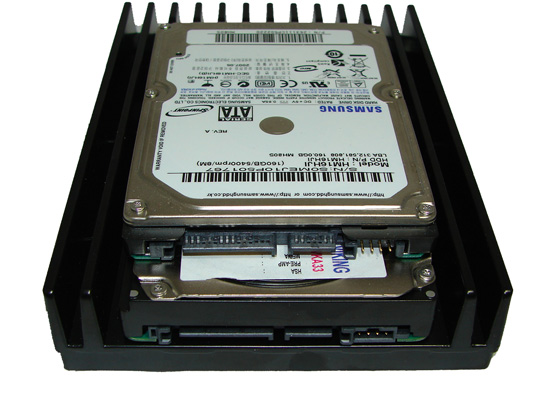
The 2.5" form factor that WD utilizes is 15mm thick compared to the standard 9mm option found in the majority of notebooks. This means the drive will not work in the majority of notebooks available today, although we would not be surprised to see a DTR design utilizing this drive in the high-end market. However, the form factor matches that of Seagate's Savvio enterprise drives and should easily plug and play where those drives are utilized.
Hook Me Up
| Standard Test
Bed Performance Test Configuration |
|
| Processor | Phenom 9850BE |
| RAM | 2x2GB GSkill PC2-8500 |
| OS Hard Drive | Western Digital Raptor 150GB 10,000RPM SATA |
| System Platform Drivers | ATI 8.4 |
| Video Cards | MSI HD 3870 |
| Video Drivers | ATI Catalyst 8.4 |
| CPU Cooling | Thermalright Ultra-120 eXtreme |
| Power Supply | Corsair CMPSU-520HX |
| Optical Drive | LG GGCH20L - Blu-ray / HD-DVD Combo |
| Case | Cooler Master CM Stacker 830 |
| Motherboards | MSI K9A2 Platinum |
| Operating System | Windows Vista Ultimate 64-bit SP1 |
| . | |
We will start utilizing three different platforms for our storage tests shortly. Our plan is to provide periodic performance comparisons of platforms based on the Intel/NVIDIA/AMD chipsets.
Our testbed uses an MSI HD-3870 video card to ensure that our benchmarks are not GPU bound. Our video tests run at a 1280x1024 resolution at High Quality settings. All of our tests run in an enclosed case with an optical/hard drive setup to reflect a moderately loaded system platform. We fully patch the OS and load a clean drive image for each platform in order to make sure that driver conflicts are minimal.
We format before each test run and complete five tests on each drive in order to ensure consistency in the benchmark results. We remove the high and low scores and report the remaining score. The Vista swap file is set to a static 2048MB and we clear the prefetch folder after each benchmark.
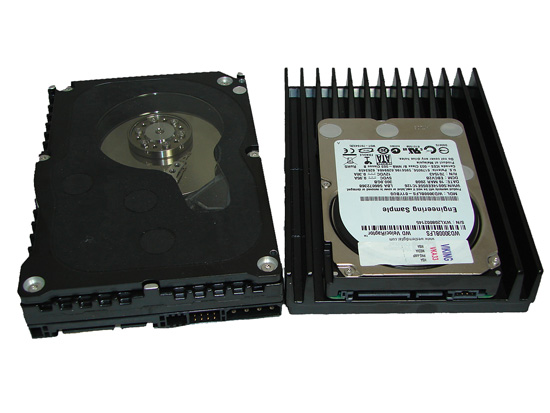
Software Test Suite
With the variety of disk drive benchmarks available, we need a means of comparing the true performance of the hard drives in real world applications. Our abbreviated benchmark suite for today's article will include:
- HD Tune
- Acoustics and Thermals
- WinRAR
- Nero Recode
- Company of Heroes: Opposing Fronts
- Crysis
- PCMark Vantage
Our benchmark suite will expand greatly for the full review of this drive and comparisons against SAS drives, including the new 1TB drive from Seagate.
Acoustics and Thermals
Our acoustic tests measure the decibel levels while the system is at idle and under load while running the Hard Disk test suite within PCMark Vantage. We take measurements at a distance of 5mm from the rear and front of the drive in a separate enclosure and report the highest reading. The test room has a base acoustical level of 20dB(A).

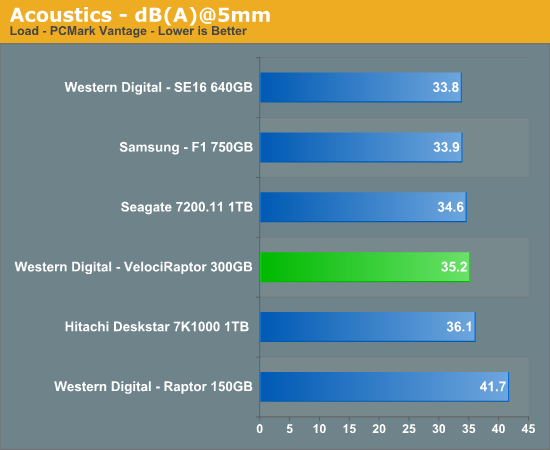
At 27.2 dB(A), this drive is almost one of the quieter drives we have tested and the results are just exceptional for a 10k RPM product. While the numbers indicate a very quiet drive at idle, the subjective take indicates a drive that has the slightest of whirling noise not present in the current 7200RPM 2.5" notebook drives. At load, this drive finishes in the middle of our test group. Like its predecessor, you know the drive is working during seek operations but the sound pressure is definitely muted. Unfortunately, our drive developed a slight clanking noise and we could not complete AAM testing on the drive.
Our thermal tests utilize sensor readings via the S.M.A.R.T. (Self-Monitoring, Analysis and Reporting Technology) capability of the drives as reported by utilizing the Active SMART 2.6 utility. We also utilize thermal sensors and infrared measurement devices to verify our utility results. We test our drives in an enclosed case environment. Our base temperature level in the room at the time of testing is 25C.
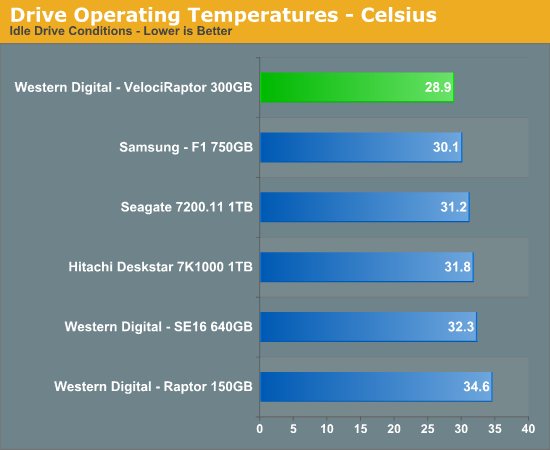
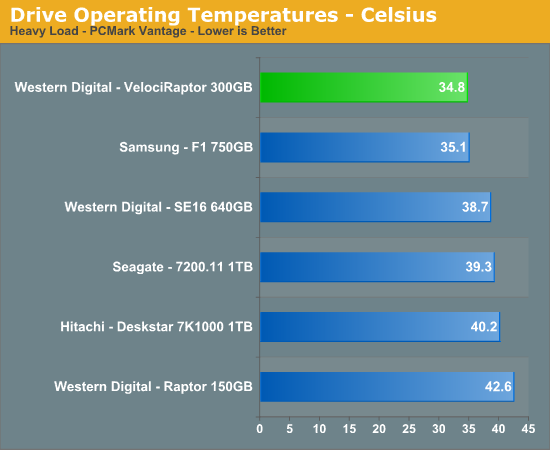
By way of its reduced power dissipation, the VelociRaptor leads our test group in both idle and load thermals even though its platters are spinning away at 10k RPM. We are still running thermal tests with and without the IcePAK chassis (do not try this at home as it will void your warranty). Western Digital's internal testing showed a 7.1C drop in temperature with the IcePAK system under normal operating conditions. We measured a 5.1C drop with the chassis attached without active cooling and an 8.2C reduction in temps with airflow across the chassis. This indicates to us that operation without the IcePAK will be fine in the enterprise market.
HD Tune Pro 3.00
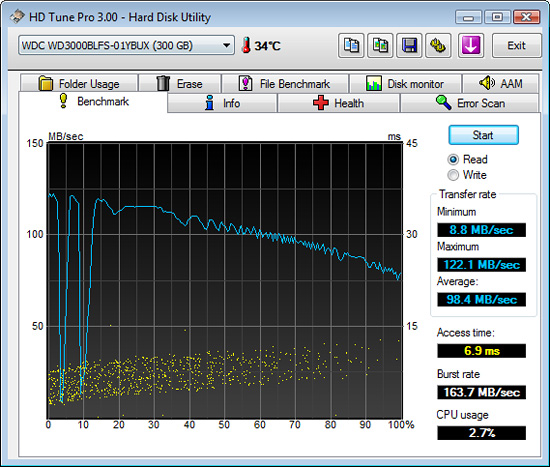

In our read tests, the VelociRaptor just runs (flies) away from the Raptor in the sustained transfer rate tests. The average transfer rate of 98.4 MB/s is about 36% faster than the 150GB drive, while burst rates improve 61% and access time by 18%. However, all is not well with our drive. Thanks to early firmware, the servo algorithms are not optimized, resulting in drastic slowdowns on the outer diameter of the platter area.
This resulted in several problems with our benchmark test suite. The consistency and validity of benchmark results did not meet our variation requirements during testing. The synthetic benchmarks typically generated results close to what WD is estimating with the final firmware results. However, our application benchmarks tell another story, especially those that have a high rate of sustained transfer activity.


In our write speed tests, we see a familiar pattern. The VelociRaptor offers a maximum write speed that is 26% faster, average write speed is 42% quicker, and burst rates are once again about 61% better. We consistently had a drop off at the beginning of the drive (the outer tracks on the platter) and it will be corrected with the final firmware revision before the drives ship.


We will expand the results of our file benchmarks in the full review. For the time being, we are showing how the two drives compare to each other with a file length of 32KB.
PCMark Vantage
PCMark Vantage is the latest benchmark available from Futuremark, and it is only for use with Windows Vista. Similar to the venerable PCMark05 in its makeup, Vantage modernizes the criteria and test methodology to reflect what users may encounter when running the new Windows OS and current applications. For the HD test suite, the white paper breaks the tests down as follows:
- Windows Defender: Windows Defender performs a scan operation, resulting in a read-intensive (99.5% read, 0.5% write) benchmark reflecting a common task in Windows Vista.
- Gaming Performance: Streaming performance is measured using actual game mechanics found in Alan Wake. This test is nearly all read (99.95% read, 0.05% write) in nature.
- Windows Photo Gallery: A large collection of images is imported into Windows Photo Gallery. This is the first of the tests which bring write performance into account in a meaningful way, with a roughly 84% read, 16% write ratio.
- Windows Vista Startup: Simulates Windows Vista startup operations, producing a test that breaks down to roughly 85% read and 15% write operations.
- Windows Movie Maker: The first of the Vantage tests which comes close to equally dividing read and write operations (54% read, 46% write), concurrent video performance is tested both for video read and skip performance, as well as video write operations.
- Windows Media Center:
Performing three distinct tasks:
- SDTV video playback
- SDTV video streaming to Extender for Windows Media Center
- SDTV video recording
- Windows Media Player: Adds music to Windows Media Player. This test reverts to favoring read operations (78% read, 22% write).
- Application
Loading: The following applications are loaded:
- Microsoft Word 2007
- Adobe Photoshop CS2
- Internet Explorer 7
- Outlook 2007
The total benchmark is roughly 87% reads and 13% writes in nature. We run each test five times per drive, producing a median score that we use for comparison in our charts.
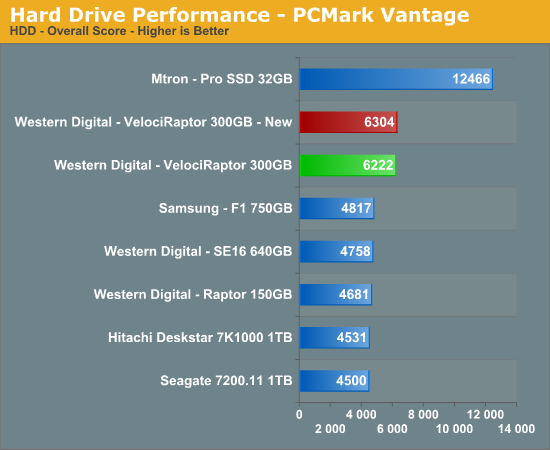
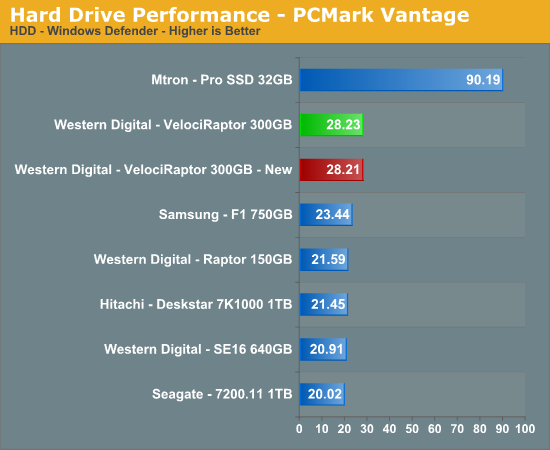
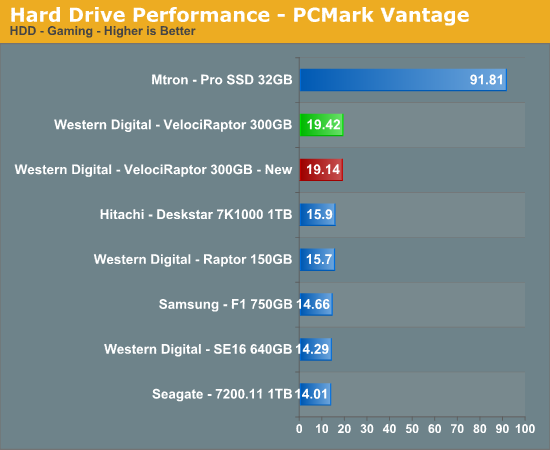
The VelociRaptor just decimates the competition in our overall score results, unless you count the almost ridiculous benchmark scores of the Mtron SSD drive.
Vantage Once Again
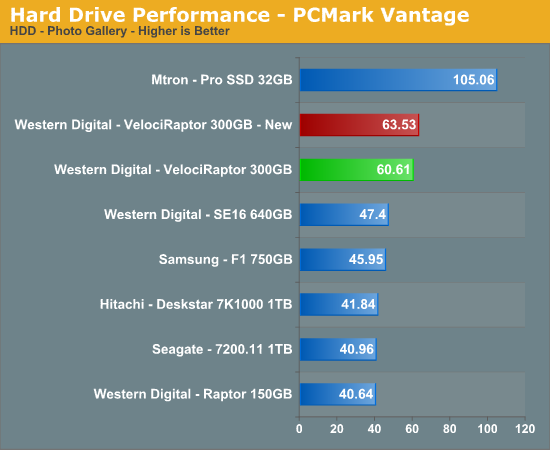
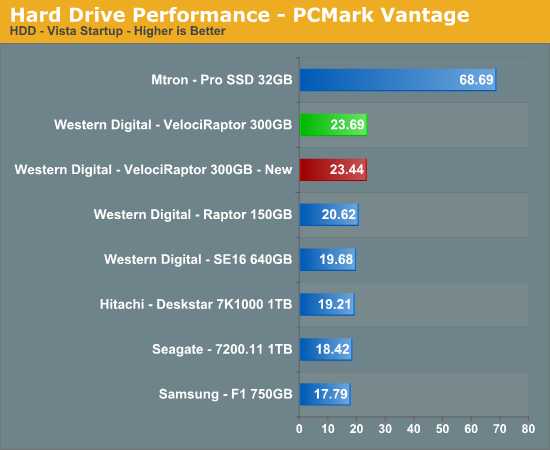

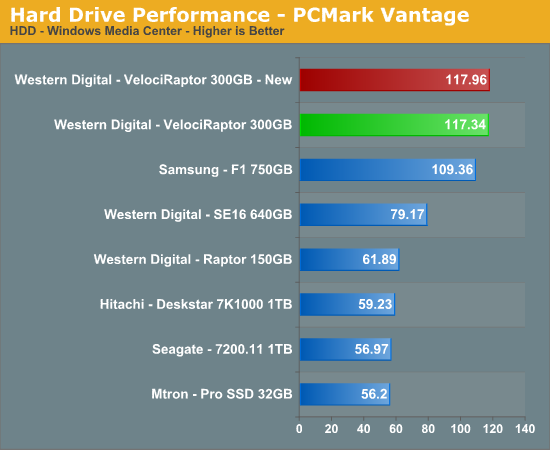
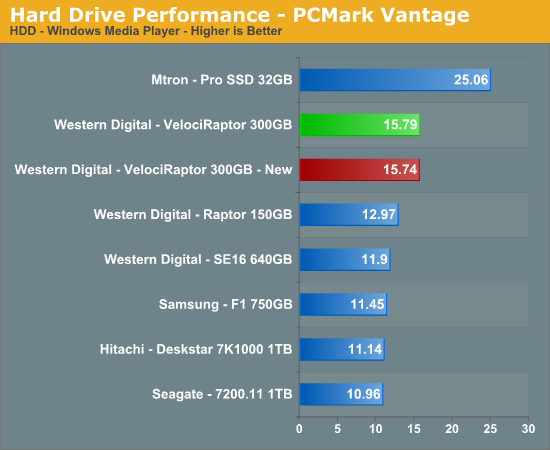

The WD VelociRaptor drive generates excellent scores in the PCMark Vantage tests that simulate real-world performance patterns utilizing a variety of actual applications. We added in our Mtron Pro SSD 32GB drive as a comparison. While PCMark Vantage utilizes actual applications for testing, the HD test provides a pure performance look at the hard drive or controller tested. Like our previous testing with iPEAK, the results show the capabilities of the hard drive without the platform penalty. In other words, these tests will indicate the true performance capability of the hard disk and should provide an indication of the drive's performance potential within the platform.
The question now is, how well does the VelociRaptor hold up in actual applications with early firmware? Let's look at our early results. For those who need high synthetic benchmark results, you can skip the rest of this article. Buy an SSD if you can afford it, and if not, buy this drive.
Let's get real now
We need to state once again that the press sample drives shipped with early firmware that is about 90% complete according to Western Digital. Their engineering group is working around the clock (we were up together until the wee hours last night) to finalize the firmware before the drives ship to Alienware or into the retail channel.
Western Digital was upfront about the state of the firmware and warned us that results might not represent the final product. We already discussed the firmware problems yesterday. In our case, it appears that besides being firmware challenged our drive might not have been the smartest or most capable of the pack either. We have returned our drive for analysis. In the meantime, our actual application results consist of benchmarks that certainly would expose the sustained transfer rate problems on the outer area of the platters.
Game Level Load
This test centers on the actual loading of a playable level within our game selections. Our application timer begins when the level load process is initiated and ends when the screen is visible.
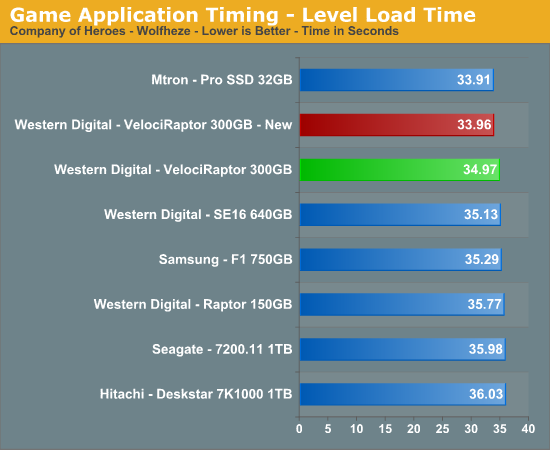
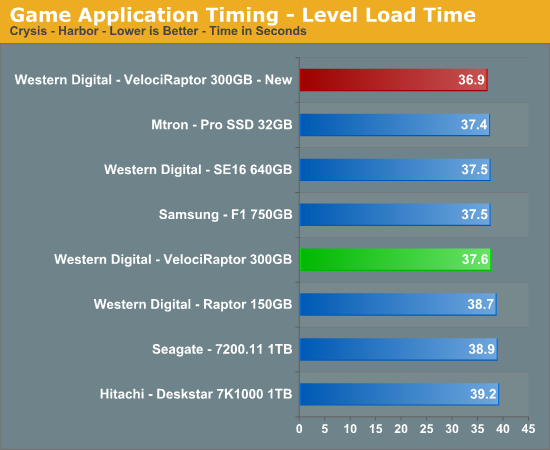
In Company of Heroes, the separation between the mechanical drives is just over a second. Our VelociRaptor is the quickest mechanical drive in this test. In Crysis, we see the VelociRaptor trailing our leaders by just .2 seconds at most. These are objective tests centered on a single level load in each game. Subjectively, the two Raptors and our SSD drive seemed to offer quicker transitions' between levels as we extended the game play length.
Nero Recode
Our encoding test is quite easy - we take our original Office Space DVD and use AnyDVD to copy the full DVD to the hard drive without compression, thus providing an almost exact duplicate of the DVD. We then fire up Nero Recode 2, select our Office Space copy on the hard drive, and perform a shrink operation to allow the entire movie along with extras to fit on a single 4.5GB DVD disc. We leave all options on their defaults except we turn off the advanced analysis option. The scores reported include the full encoding process in seconds, with lower numbers indicating better performance. We delete each image after use.

We had a slight surprise in this test as the original Raptor finishes about two seconds ahead of our star. It was obvious watching the encode process that the VelociRaptor's time stumbled and stalled at the beginning of the test and then the drive made up ground quickly that allowed it to almost catch our previous mechanical champ. The Mtron SSD drive once again flexes its muscles.
WinRAR 3.71
Our WinRAR test measures the time it takes to compress our test folder that contains 444 files, 10 folders, and 602MB of data. While the benchmark is CPU intensive for the compression tests, it still requires a fast storage system to keep pace with the CPU. A drive that offers excellent write performance can make a difference in this benchmark.
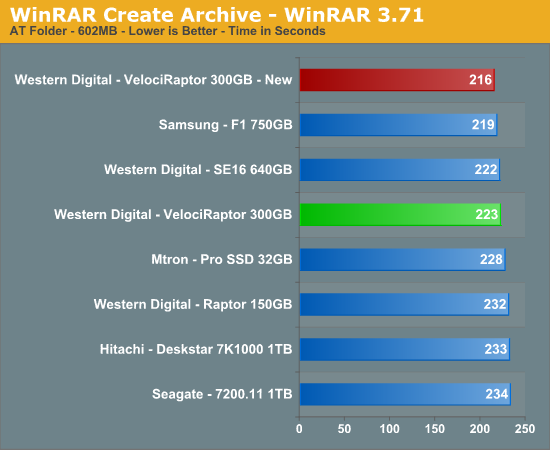
This test relies on the CPU and the burst rate of the storage system. Our VelociRaptor finishes in third this time and trails the Samsung 750GB and WD 640GB offerings. Once again, at the beginning of the test the drive stumbled out of the gate and then finished strong.
File Copy Performance
Our file copy test measures the time it takes to transfer our first test folder that contains 29 files, 1 folder, and has 7.55GB of data from our source drive to the target test drive. The second test folder contains 444 files, 10 folders, and 602MB of data. These benchmarks are disk write intensive and require a fast storage system.

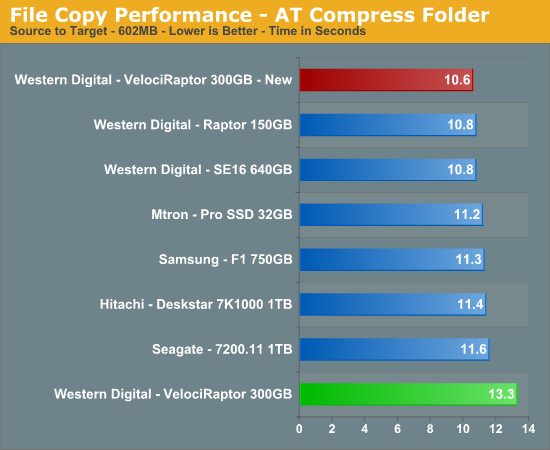
We finish our application tests with benchmarks that should favor the Raptor family because it represents a pure write scenario where speed kills. In this case, our VelociRaptor got its talons handed to it. We ran these tests repeatedly with the same results for the most part. The sustained write performance of the VelociRaptor was continually hampered by the slowdown/speedup write operations on the outer tracks.
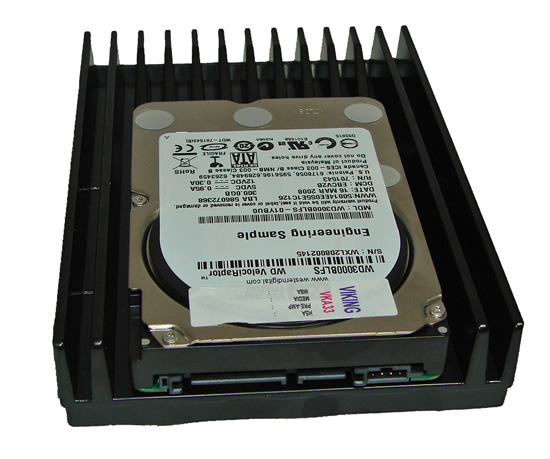
First Thoughts
We are actually not going to come to any conclusions yet on what appears to be a very impressive piece of engineering work from Western Digital. The VelociRaptor VR150 is indeed a huge leap in design - and in certain cases, performance - over the original Raptor. While the two drives share a common 10k RPM design, everything else about the drives, sans the warranty and black paint, is different.
Sometimes changing too much leads to disaster, but in this case, we are glad that Western Digital burned the Raptor blueprints and started over. The 2.5" form factor, low power consumption, and excellent acoustics will be appreciated in the enterprise market where saving money on energy and storage footprints are extremely important now, or should be. In a nod to the enthusiast sector that made the original Raptors kings of desktop performance, Western Digital did not leave us out in the cold, but instead provided the IcePAK chassis for our 3.5" form factor case requirements.
Our only problem at this point is that we could not complete our review. The early firmware problems caused havoc in our application benchmarks, so much so that we left out several results, as we knew the drive should perform better. Our comparisons against entry-level SAS drives suffered the same fate. Yes, the drive was extremely fast in IOMeter and other tests we ran, but we did not trust the results at this point. We expect new firmware and a new drive shortly and will finish our review at that time. Until then, this is one dinosaur we would not want to mess with.







